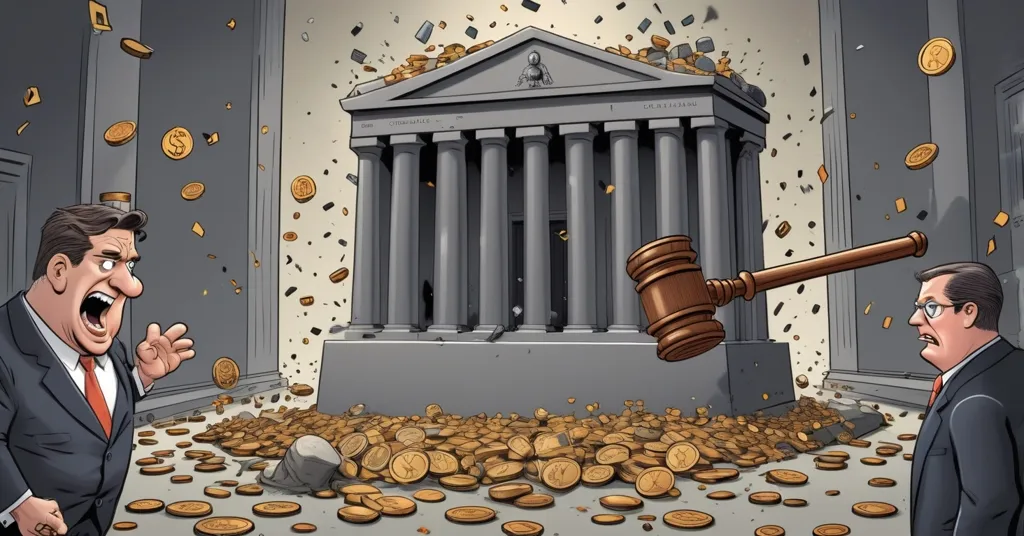Bank of America Fined $540M by FDIC for Underpaying Insurance Fees

Bank of America Ordered to Pay Over $540 Million in Deposit Insurance Fees
Bank of America (BofA), one of the largest financial institutions in the U.S., has been ordered by a US district judge to pay over $540 million for underpaying deposit insurance fees. This ruling comes after a lawsuit filed by the Federal Deposit Insurance Corporation (FDIC), which accused BofA of short-changing them by more than $1.12 billion between Q2 2013 and Q4 2014. Deposit insurance fees are payments banks make to the FDIC to ensure customer deposits up to $250,000 per account are safe, even if the bank fails.
- Bank of America fined over $540 million by FDIC.
- Accused of underpaying $1.12 billion in fees from 2013-2014.
- Inaccurate reporting led to lower risk scores.
- Judge upheld FDIC’s rule as valid.
The FDIC’s Allegations
The FDIC filed a lawsuit against BofA in 2017, claiming the bank had unjustly enriched itself by retaining over $1.12 billion in deposit insurance fees. These fees are crucial for maintaining the stability of the banking system. The FDIC argued that BofA failed to consolidate its counterparty exposures, which refers to the total amount of money the bank owes to other parties, to the ultimate parent level as required by regulations introduced after the 2008 financial crisis. This oversight resulted in lower risk scores for BofA, leading to reduced insurance payments.
An FDIC audit in 2016 revealed the extent of BofA’s non-compliance with the 2011 Rule:
In 2016, an FDIC audit revealed that ‘[BofA] had not consolidated its counterparty exposures to the ultimate parent level as required…’ This lowered [BofA’s] concentration measure, which in turn considerably lowered the overall amount that BANA paid in assessments for those quarters.
The 2011 Rule was implemented to enhance risk-based deposit insurance assessments following the financial crisis, ensuring banks contribute fairly to the FDIC’s insurance fund, which is vital for depositor confidence and financial system stability.
Bank of America’s Defense
In response to these accusations, BofA argued that it had correctly interpreted the post-2008 financial crisis regulations and lacked fair notice of the FDIC’s interpretation. However, US District Judge Loren L. Alikhan saw things differently:
The court agrees with the FDIC that, after reading the text of the 2011 Rule and ‘acting in good faith,’ [BofA] should have been able to ‘identify[] with ascertainable certainty, the standards’ it was expected to apply.
Judge Alikhan rejected most of BofA’s arguments, emphasizing the importance of accurate risk reporting.
The Court’s Ruling
While the FDIC initially claimed over $1.12 billion, Judge Alikhan reduced the amount to $540,261,499 plus interest, acknowledging that claims for earlier periods were time-barred. This ruling not only enforces the importance of accurate risk reporting but also sets a precedent for how banks must report their risk exposures.
BofA’s response to the ruling was pragmatic. Bill Haldin, a BofA spokesperson, noted that the bank had reserves to cover the decision. Meanwhile, the FDIC’s willingness to adjust its initial claim reflects its commitment to fair enforcement based on legal findings.
Implications for Banking and Cryptocurrency
This case is a stark reminder of the critical nature of regulatory compliance in the banking sector. BofA’s failure to adhere to the 2011 Rule has led to significant financial repercussions, underscoring the FDIC’s role in ensuring banks contribute fairly to the insurance fund that maintains depositor confidence and financial system stability.
The broader implications of this case could lead to increased scrutiny of other banks’ reporting practices and may prompt a review of existing regulations to ensure clarity and enforceability. As the second-largest bank in the U.S., with a recent first-quarter profit of $7.4 billion and $27.37 billion in revenue net of interest expense, BofA’s financial resilience is evident despite this legal setback.
In the realm of cryptocurrency and blockchain, where decentralization and transparency are championed as the future of finance, cases like this highlight the ongoing challenges within traditional banking systems. While Bitcoin and other cryptocurrencies aim to disrupt the status quo, offering a more transparent and less regulated alternative, the issues faced by BofA serve as a reminder of the complexities and potential pitfalls of the current financial framework. As advocates of effective accelerationism and financial freedom, understanding the lessons from the traditional sector is crucial to better inform our journey towards a decentralized future.
Key Questions and Takeaways
- What was the total amount Bank of America was originally accused of underpaying in deposit insurance fees?
Bank of America was originally accused of underpaying $1.12 billion in deposit insurance fees.
- What was the final amount Bank of America was ordered to pay, including interest?
Bank of America was ordered to pay over $540.26 million plus interest.
- Why did the FDIC sue Bank of America?
The FDIC sued Bank of America because the bank failed to accurately report its counterparty exposures, leading to lower risk scores and reduced insurance payments, thereby underpaying its deposit insurance fees.
- What was Bank of America’s defense against the FDIC’s allegations?
Bank of America defended itself by arguing that it correctly interpreted post-2008 financial crisis regulations and lacked fair notice of the FDIC’s interpretation of the rule.
- What did the FDIC audit in 2016 reveal about Bank of America’s reporting?
The FDIC audit in 2016 revealed that Bank of America had not consolidated its counterparty exposures to the ultimate parent level as required, which led to lower risk scores and reduced insurance payments.
As we continue to champion decentralization and the potential of blockchain technology, cases like BofA’s serve as a critical reminder of the need for transparency and accountability in all financial systems. Whether through traditional banking or the emerging world of cryptocurrencies, the lessons learned here are invaluable for anyone invested in the future of finance.



